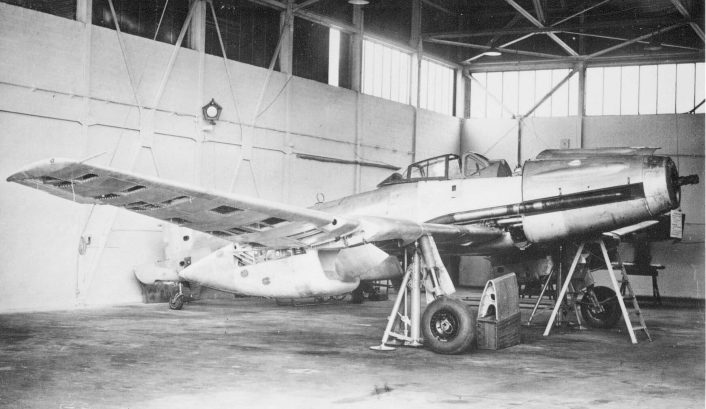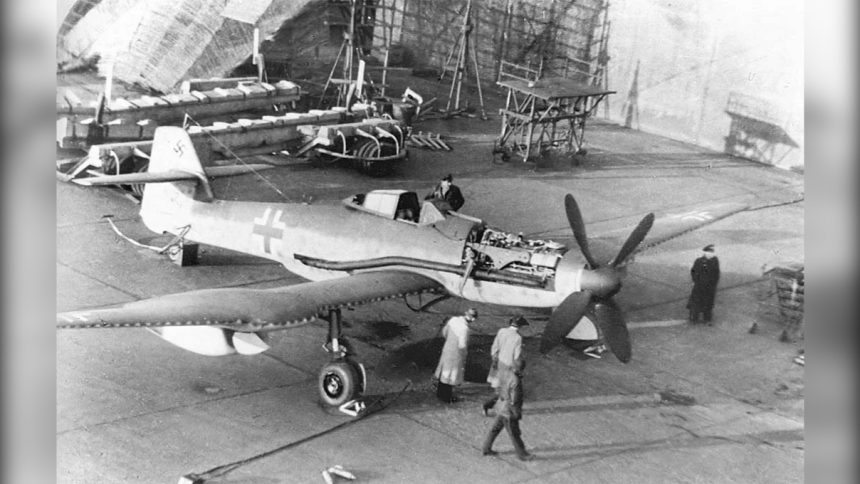First conceived by Messerschmitt as a carrier-borne fighter, the Me 155 morphed into a high-speed attack plane and later a high-altitude interceptor known as the Blohm & Voss BV 155.
Nazi Aircraft Carrier
An agreement on June 18, 1935, with the British allowed Germany the construction of two aircraft carriers. Construction of Germany’s first aircraft carrier began on the Dec. 28, 1936, at Deutsche Werke shipyard in Kiel. On Dec. 8, 1938, the carrier was launched, christened the Graf Zeppelin in honor of the famous airship designer.
The only aircraft carrier launched by the Kriegsmarine (German Navy) would have a complement of 42-43 aircraft, consisting of a mix of fighters (Messerschmitt Bf 109T), torpedo bombers/reconnaissance (Fiesler Fi 167), and dive bombers (Junkers Ju 87C-1). Graf Zeppelin had a length of just over 821 ft with a beam of 118 ft 9 in, and displaced over 34,000 tons fully loaded. Steam-geared turbines gave her 200,000 shaft horsepower (SHP) and moved her at speeds up to 34 knots.
The ship was 85% complete at the outbreak of World War Two, but was never completed or operational. At 90% completion Graf Zeppelin was moved on July 12, 1940, to Gotenhafen (Gdynia), Poland, for safety and redesign. Thinking the war would be over soon, construction on the ship halted with other priorities and needs at the time due to the war.
However, in the spring of 1942, Admiral Erich Raeder requested the carrier be completed for use in commerce raiding operations. Work resumed on the carrier after being towed back to Kiel in Dec. 1942, with the carrier’s projected aircraft complement now being 28 bombers and 12 fighters. By now the planned carrier fighter, the Messerschmitt Bf 109T, was becoming obsolete. Messerschmitt was asked to introduce a new proposal for a shipboard fighter.
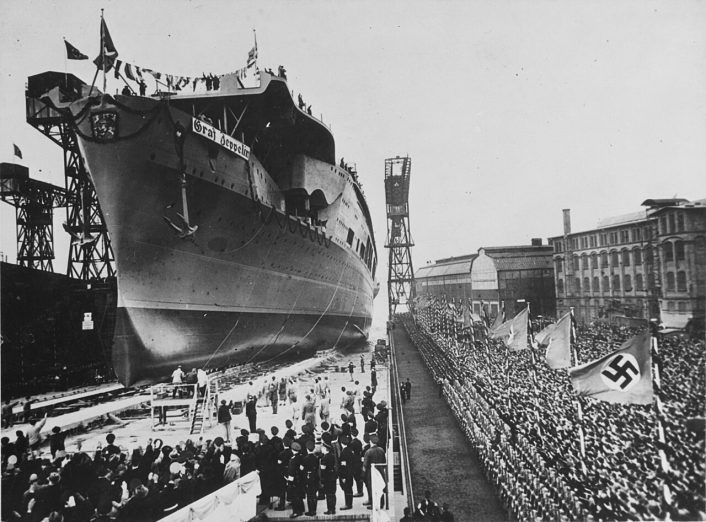
The Messerschmitt Me 155
In order to expedite production as well as ease manufacturing for an already overloaded wartime staff, the new carrier fighter was to utilize as many components of the existing Bf 109 as possible. In late Dec. 1942, the design of the Me 155 was complete. The fuselage would consist mainly of a standard Bf 109G along with tail surfaces, but coupled with an entirely new wing with a 36 ft 3.5 in wingspan.
The main landing gear, with a more carrier-friendly widened stance, would retract inward into wing wells, while the wings had provisions for folding enhancing aircraft storage. Arresting gear as well as catapult spools was also incorporated. Power would come from a Daimler Benz 605A-1 producing 1,475 horsepower at takeoff, and the aircraft had an estimated top speed of 403 mph.
The Me 155’s proposed armament consisted of an engine-mounted 20 mm MG 151 cannon with 220 rounds available along with two additional MG 151 cannon with 240 rounds per gun and two MG 131 13 mm machine guns with 250 rounds each in the wings. The heavily armed fighter would have a maximum take-off weight of 7,784 lb.
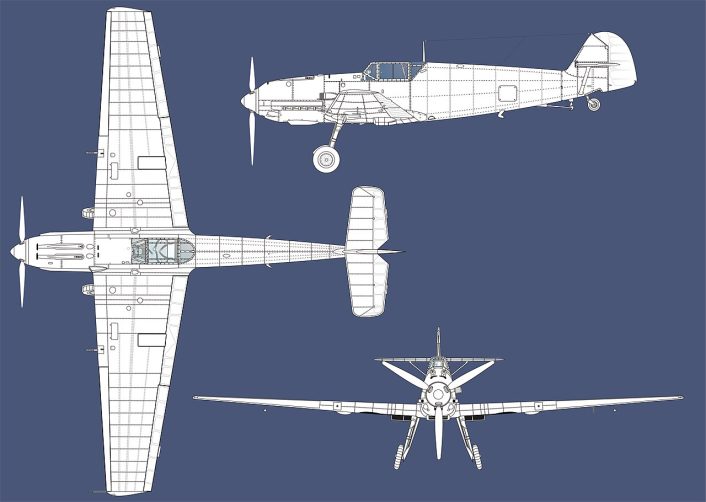
In the meantime, so many changes in the design of the Graf Zeppelin had been added; it would now be at least another two years before it could become operational. In addition, Hitler had an aversion to large surface vessels, and being disappointed in the performance of the Kriegsmarine, he ordered the large ships taken out of service and scrapped.
This halted the work on the carrier once again in 1943, with the new Admiral in charge, Karl Dönitz, persuading Hitler to void the order scrapping of most of the larger ships. The carrier once again was moved, this time back to Stettin (Szczecin), Poland, where it had previously spent time in 1941, being moved there from Gotenhafen. Messerschmitt was asked to shelve the Me 155 project.
In an effort to prevent the time and resources spent on the Me 155 from being wasted, Messerschmitt modified the aircraft design and proposed it to fulfill a requirement for high-speed single-seat attack aircraft capable of pinpoint bombing attacks with a single 2,205 lb bomb. The carrier equipment was removed and additional fuel cells were added with some of the armament deleted to save weight. A longer non-retracting tailwheel leg was added in order to provide sufficient clearance for the large bomb during take-off. Maximum speed while carrying the bomb was estimated to be 317 mph. However, the new design, known as the Me 155A, was not accepted.
The buildup of American bombers in Europe in late 1942 began to catch the attention of the Germans. Concerns arose over intelligence indicating a pressurized high-altitude bomber, known as the Boeing B-29, was being developed by the United States, and it might be encountered in the skies over the Third Reich flying above the effective combat ceilings of existing Luftwaffe (German Air Force) aircraft. Again, the Me 155 would be redesigned for yet another role, this time high-altitude interception.
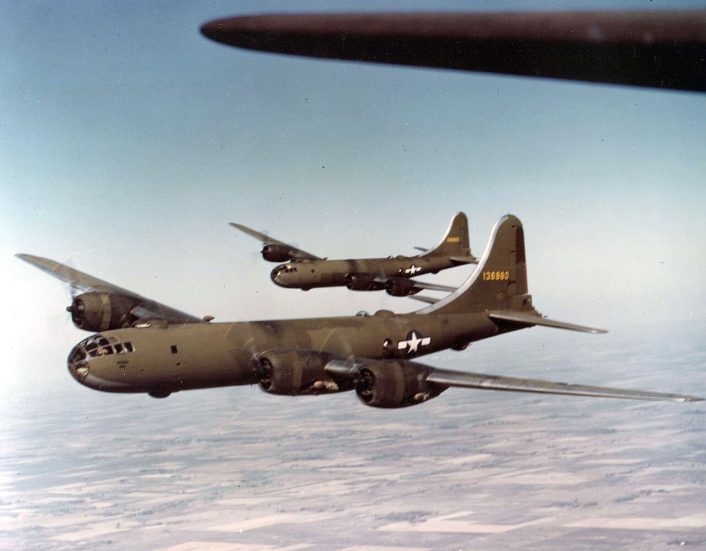
The Messerschmitt Me 155B
Willy Messerschmitt once again took a standard Bf 109G along with the standard Bf 109 wings and added an un-tapered wing center section with the 109 wings fitted outboard. This extended the wingspan to 42 ft 8.5 in. A pressurized single-seat cabin was provided as well. A Daimler Benz 603 engine was eventually chosen for power, being fitted with an exhaust driven TKL 15 supercharger. This required the fuselage to be elongated, placing the supercharger aft of the cabin. Exhaust gases were carried along the fuselage by external ducts driving the turbine being coupled through a hydraulic drive to a two-stage centrifugal impeller. A ventral trough just aft of the wings provided motor induction air. Four shallow coolant radiators were placed under the wing center section.
The final design, designated the Me 155B-1 and known to Messerschmitt as P.1091, included a vertical tail from another Messerschmitt design, the Me 209, with the horizontal tail retained from the Bf 109G along with the landing gear. Being overtaxed with design work, the project was sent to a design office in Paris staffed with French aircraft designers, who made little progress. In August 1943, the German Air Ministry (Reichsluffahrtministerium; RLM) determined Messerschmitt was over burdened with previous commitments, production, and development programs. Messerschmitt was instructed to turn the Me 155B program, including all drawings and calculations, over to the Blohm & Voss company.
The BV 155
Blohm & Voss were well-known shipbuilders as well as successful at building sea planes, but the firm was somewhat new to interceptor/fighter aircraft. A team led by Dr. Richard Vogt determined the Me 155 project had too many flaws to produce an effective high-altitude fighter, resulting in worsening relations and increased friction between Messerschmitt and Blohm & Voss.
Blohm & Voss had been directed by the German Air Ministry to begin construction of the aircraft with Vogt obtaining Messerschmitt’s blessing for any changes to the existing design. The two sides failed to reach any agreement and eventually Dr. Vogt presented the RLM a list of redesigns that was quite extensive.
The list included redesigning the following: the structure of the center wing section, fuel housing arrangements, the undercarriage and its stowage, the radiators, the wing profile, installation of the supercharger, and the horizontal tail surfaces. After a series of unproductive meetings between all parties involved, the RLM overruled Messerschmitt and allowed Blohm & Voss complete design responsibility and ordered three prototypes.
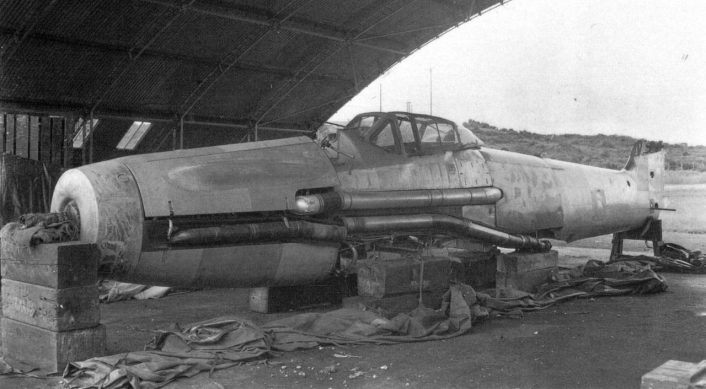
Vogt and his team went to work, adopting a laminar flow airfoil section and abandoning Messerschmitt’s idea of using standard Bf 109G wings for the outer sections. The center section of the wing was also redesigned, and after wind tunnel tests revealed that two large radiator intakes over the trailing edges of the center section were far more efficient than the original four mounted beneath the center section of the wing, and since they would not be obstructed by retracting landing gear, they were incorporated into the new design. Undercarriage legs and wheels from a Junkers Ju 87D-6 replaced the Bf 109G units, along with the aft fuselage being reinforced. The vertical tail section was enlarged and the horizontal tail surfaces of the Bf 109 replaced.
The first prototype, the Me 155 V1, later re-designated the BV-155B V1, flew on Sept. 1, 1944. The aircraft was powered by a Daimler Benz 603A supercharged engine creating 1,450 horsepower with a four-bladed wooden propeller, and a fuel capacity of up to 317 gallons. The cockpit included an ejection seat and was pressurized; the side-opening canopy fitted with an inflatable rubber seal.
On Feb. 8, 1945, a second prototype designated the BV 155B V2 joined the flight test program, and included further redesigns. Flight tests with the V1 version had shown that during high angles of attack, the airflow to the radiators mounted atop the leading edges was restricted by the wing and causing coolant temperatures to rise to alarming levels.
It was decided that increasing the retraction speed of the landing gear so it would not cause a major disruption in cooling efficiency along with enlarging the radiator intakes, would allow the radiator intakes to be placed back below the wings. To achieve this, the cockpit was moved forward and a sliding canopy added which increased visibility. The rear decking was cut down and the vertical fin enlarged along with the rudder. Horizontal tail surface area was increased.
Some records indicate the prototype V2 made an emergency landing on soft ground with only minor damage, but use of an armored personnel carrier and chains around the wings to remove the aircraft caused so much damage that the V2 was unrepairable. A BV 155B V3 version was under construction, the main change being the engine, utilizing a Daimler Benz 603U that was planned for the BV 155C, but it was never completed due to concentrating efforts on the V2.

More conventional in appearance, the BV 155C V4 was yet another design change, incorporating a much more compact and conventional liquid cooling system. The troublesome wing-mounted radiators were replaced with a single chin-mounted radiator. The wing would also differ, with the outer panels now attaching directly to the center section with the radiator sections removed. A forward leading edge extension was added at the wing roots. Elimination of the wing-mounted radiators meant the wing root extensions now accommodated the retracting landing gear. The war ended before construction of the V4 could begin.
Had the war continued on in late 1945 and into 1946, American Boeing B-29 Superfortress bombers may have indeed become a common sight in the skies over Germany, and might have faced stiff opposition from the BV 155 with its impressive high-altitude performance. The BV 155B had a large wingspan of over 67 ft and, along with its complex supercharged engine, it is estimated speeds of over 420 mph were possible with a maximum ceiling of over 55,000 ft.
Several armament packages were proposed for these aircraft, including various combinations of 30 mm and 20 mm cannon, which would have been deadly on the large B-29 bombers. The Focke-Wulf Ta 152 was a contemporary of the BV 155, and was put in production, capable of the same mission of high-altitude intercept; though it arrived too late in too small of numbers to make a difference.
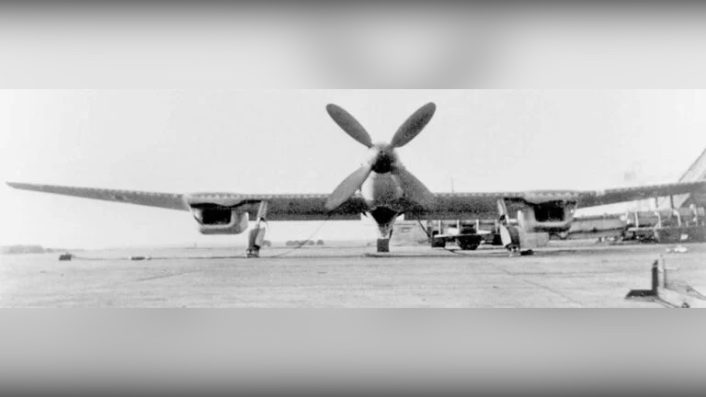
Final Disposition and Mystery
At the end of World War Two, the British came into possession of the three BV 155 prototypes. One account claims the V1 was deemed airworthy and the RAF attempted to fly it back to England, but it crashed shortly after takeoff and was destroyed. The V2 and V3 were said to be shipped to Farnborough, England, for evaluation. Another account states the V1 was taken by the British for evaluation and later scrapped and the V2 was considered for flight tests but was simply displayed from Oct. to Nov. 1945 and then placed in storage.
Some sources indicate it was the V1 that crashed while in German hands and was damaged with the chain and armored personnel carrier recovery, and that the V2 was incomplete along with the V3 when allied forces arrived at the factory. Other sources state the V2 did fly and was the aircraft that crashed, and it seems evidence supports this, including photographs.
In any event, one of the airframes was eventually sent to the United States for evaluation at Wright Field, Ohio. It was thought to be the unfinished V3 for years, and eventually it was transferred to the Smithsonian National Air and Space Museum. However, restoration research experts now believe the aircraft in storage at the Smithsonian’s Paul E. Garber Facility is actually the V2 after determining the aircraft to be 90-95% complete compared to German records showing the V3 only 50-75% complete at war’s end, and in addition researchers discovered “V2” stamped on both sides of the windshield frame.
If the Smithsonian’s airframe is indeed the V2, then it is unclear of the fate of the V3, and it is unclear if the V1 crashed during German testing or the V2, and if the V2, was it repaired by the Allies or Germans to the extent the chain damage is no longer visible leading to the belief the airframe was the V3 for years? Or did the Germans repair it or begin to repair it to flight worthy status?
As for the fate of Nazi Germany’s only aircraft carrier launched, the Graf Zeppelin sat out the war for the most part sans one bombing raid by the Royal Air Force. Still at Stettin, Poland, at war’s end, German combat engineers were ordered on Apr. 24, 1945, to demolish with explosive charges the ship’s critical components such as turbines, power generators, and lifts.
Scuttled, the Graf Zeppelin became a war prize for the Soviet Union. The Soviets refloated the damaged ship in 1946. Mystery surrounded what actually happened next, with the Iron Curtain clouding the view. One speculation had the carrier towed to Leningrad but striking a mine off Finland and then being broken up for scrap upon arrival in Leningrad. Another theory stated the ship left Stettin under tow for Leningrad but never arrived.
However, Soviet records state the carrier was towed to Swinemunde harbor and subject to a series of controlled explosions; testing various bombs used for dive bombing. Despite this, Graf Zeppelin stayed afloat and on Aug. 18, 1947 the ship was subject to torpedo strikes with the Soviet destroyer Slavny torpedoing her and sending her to a watery grave. In 2006 a wreck was discovered by a Polish oil company at a depth of 260 ft. Further surveying from the Polish Navy concluded it is the Graf Zeppelin.
